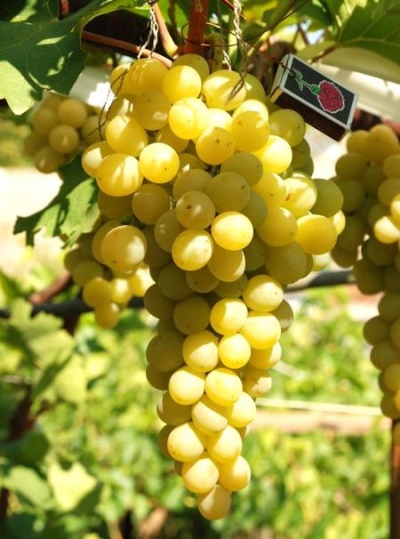
- Authors: Alberto Pirovano
- Appointment: dining room
- Berry color: matt, covered with thick prune
- Taste: nutmeg
- With bones: Yes
- Ripening period: mid-late
- Ripening period, days: 152-160
- Name synonyms: Goldoni, Dona Sofia, Ideal, Italian Muscat, Italy Muscat, Pirovano 65.
- Bunch weight, g: 600
- Flower type: bisexual
Grapes Italy - a variety with more than a century of history, registered in many warm countries, where grape crops give a lot of energy and space. The variety belongs to the Vitis vinifera species and is popular among professionals and amateurs.
Breeding history
The origin of table grapes is an intraspecific hybrid Vitis vinifera, bred in 1911 by Alberto Pirovano by crossing the two parent varieties Bikan and Hamburg Muscat. Alberto used Bikan as a mother, which is justified by the flowering of functional female flowers. Muscat of Hamburg, whose pollen was pollinated by Bikan, acted as the father's vine. It was from him that hybrid Italy received most of the excellent qualities. Name synonyms:
Ideal;
Goldoni;
Muscat Italy;
Italian Muscat;
Dona Sofia;
Pirovano 65 (Pirovano 65).
The crop is consumed fresh, used for canning (juices, preserves, jams) and pickling. The whimsical vine requires particularly careful maintenance.
Geography of distribution
The variety is grown in all countries with warm climates where table grapes are grown. In Russia, it is grown in areas with the necessary SAT (sum of active temperatures) 3250 degrees Celsius - the Black Sea coast, Crimea. And also in the North Caucasus, Moldova and other places.
Description
Vigorous bushes with a crown of a young shoot in tomentose pubescence, painted in a light color, covered with golden-green, large five-lobed leaves, strongly dissected into 5 parts. The variety has good affinity with most popular rootstocks.
Ripening period
The variety belongs to the mid-late varieties, it takes at least 152-160 days to achieve technical and physiological ripeness. Harvesting begins no earlier than the end of September.
Bunches
Cylindro-conical clusters that have reached technical ripeness have a loose structure. The average weight of a bunch is 600 grams, length 18-21 cm, width 12-15 cm. Herbaceous comb up to 4 centimeters long, rather fragile, break off easily. The bunch is not prone to peas.
Berries
Light green, oval or ovoid matte berry, covered with a thick layer of pruin, has from 2 to 4 large seeds, weighs up to 6 grams. Sugar content of ripe fruits - 148-191 g / dm³. However, the indicators are uneven - they depend on the climatic zone and the time of harvest. The titratable acidity is 6–10 g / dm³. The fleshy flesh is covered with a thick, dense skin, which contributes to long-term storage and high transportability. Fruit size is 26-30 mm in length and 18-20 mm in diameter. On a ten-point tasting scale, Italy is rated at 8.7 points. Another distinctive feature of Italy is that in areas with a subtropical climate, bunches can be left on the vine after the onset of technical ripeness. Berries are not prone to cracking even when it rains, while they increase the percentage of sugar content and the quality of varietal aroma.
Taste
The berry has a harmonious taste with an unusual but very pleasant aroma. Muscat notes with citron prevail.
Yield
In this regard, Italy is a grape with inconsistent performance: sometimes it is a record 225 g / c with good agricultural technology, and on personal plots 10-15 kg per bush.With insufficient care or unfavorable weather conditions, the indicators drop sharply.


Growing features
The cultivation of Italy requires increased attention to care, feeding and protection from disease.
Landing
To do this, choose the warmest places with good protection from winds and drafts. The ideal location is the upper exposure of the southern slope or the warm sunny side of the building. Vigorous bushes require a significant nutrient area - 4.5-5 square meters.

Pollination
Italy blooms with bisexual flowers, does not need additional measures, is well pollinated in any weather.
Pruning
Experts recommend large-scale formation of bushes with a good supply of perennial wood. Up to 10-12 eyes are left on the vine. For the entire bush, the load should not exceed 45-50 eyes, the bushes are not prone to overload. All sterile shoots are completely removed, leaving a small amount in case the bush has a significant crop underload.



Top dressing
The plant is not resistant to fungal and parasitic diseases, so gardeners use a wide range of fungicides or copper sulfate solution. The number of sprays during the growing season is quite significant - up to 10 times.
Frost resistance and the need for shelter
Indicators in this area are small, the frost resistance of the plant is rather weak - the maximum negative temperatures are up to -18 degrees. The variety needs shelter for the winter, observing the usual rules. Open wintering is possible only in the subtropics.

Diseases and pests
Italy is affected by root aphids, gray mold and mildew. Especially prone to powdery mildew.

If a grape is exposed to any disease or insect, this always affects its appearance.
Storage
The dense thick skin promotes long-term storage in cool conditions - at 4-7 degrees above zero.
Review overview
Most gardeners, on whose sites it is possible to cultivate grapes in Italy, are happy to note a pleasant aroma, dessert sweetness and harmonious taste with a pronounced nutmeg and citron aftertaste. Owners of vineyards in a subtropical climate note as an undoubted advantage of the variety its transportability over long distances without damage.











































































